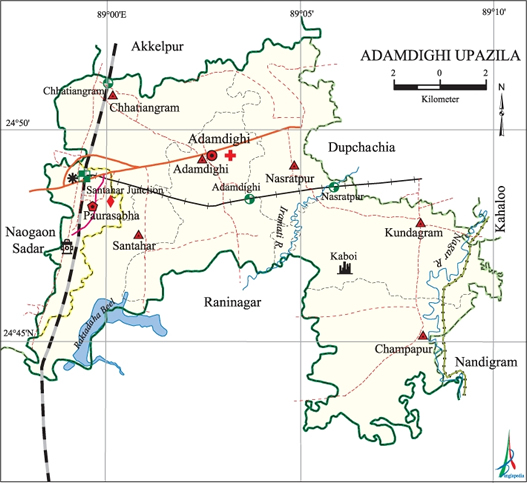Adamdighi Upazila
Adamdighi Upazila (bogra district) area 168.84 sq km, located in between 24°43' and 24°52' north latitudes and in between 88°58' and 89°10' east longitudes. It is bounded by akkelpur and dhupchanchia upazilas on the north, raninagar upazila on the south, kahaloo and nandigram upazilas on the east and naogaon sadar upazila on the west.
Population Total 187012; male 94997, female 92015; Muslim 170380, Hindu 16526, Buddhist 38 and others 68. Indigenous community such as Pahan belongs to this upazila.
Water bodies Nagar and Iramati rivers and Raktadaha beel are notable.
Administration Adamdighi Thana was formed in 1821 and it was turned into an upazila on 14 September 1983.
Archaeological heritage and relics Kaboi Rajbari (palace), Kalachand Temple.
| Upazila | ||||||||
| Municipality | Union | Mouza | Village | Population | Density (per sq km) | Literacy rate (%) | ||
| Urban | Rural | Urban | Rural | |||||
| 1 (Santahar) | 6 | 112 | 174 | 38390 | 148622 | 1108 | 57.6 | 48.5 |
| Municipality | |||||
| Area (sq km) | Ward | Mahalla | Population | Density (per sq km) | Literacy rate (%) |
| 10.20 | 9 | 35 | 30287 | 2969 | 58.8 |
| Upazila TownArea (sq km) | Mouza | Population | Density (per sq km) | Literacy rate (%) |
| 4.93 | 5 | 8103 | 1644 | 53.4 |
| Union | ||||
| Name of union and GO code | Area (acre) | Population | Literacy rate (%) | |
| Male | Female | |||
| Adamdighi 13 | 6560 | 15147 | 14239 | 51.07 |
| Kundagram 54 | 7265 | 12082 | 12023 | 44.23 |
| Champapur 27 | 7674 | 11847 | 11609 | 47.97 |
| Chhatiangram 40 | 6824 | 14393 | 13956 | 49.20 |
| Nasratpur 67 | 5920 | 13403 | 13052 | 51.07 |
| Santahar 81 | 4954 | 12511 | 12463 | 48.04 |
Source Bangladesh Population Census 2001,Bangladesh Bureau of Statistics.
Historical events Once Santahar of this upazila was an important railway junction of the British India. The Bangalis of this upazila started resistance movement on hearing the historic seventh march address by Bangabhandu sheikh mujibur rahman. They disrupted the railway lines and also created barricade by dismantling the Santahar-Bogra road. The Non-Bengali police of the Santahar GRP Thana led by Havilder Harun attacked the Bangalis with arms and ammunitions collected from the armoury and killed three Bangalis. They also killed three Bangalis in another incident at Santahar. In this situation the Bangalis led by the General Secretary of Adamdighi Thana Student League captured arms from nearby Raninagar thana and attacked the Biharis. In April the resistance movement by the Bangalis killed about 30 thousand non-Bengalis. In retaliation, the Pak army killed many innocent Bangalis of Santahar in April. Besides, the Pak army, in collaboration with the rajakars, killed a number of freedom fighters of the upazila. Adamdighi upazila was liberated on 14 December.'

Marks of War of Liberation Memorial monument 1.
Religious institutions Mosque 312, temple 21, church 2, tomb 2. Noted religious institutions: Shahi Mosque at Kundagram, Tarapur Mosque and Station Jami Mosque.
Literacy rate and educational institutions Average literacy 50.4%; male 55.5%, female 45.1%. Educational institutions: college 7, secondary school 28, primary school 93, community school 2, satellite school 4, madrasa 14. Noted educational institutions: Santahar College (1967), Adamdighi IPJ High School (1918), Santahar BP High School (1929).
Cultural organizations Club 10, press club 2, cinema hall 3.
Main sources of income Agriculture 15.26%, non-agricultural labourer 0.86%, industry 0.08%, commerce 1.29%, transport and communication 0.42%, service 13.11%, construction 51.96%, religious service 0.43%, rent and remittance 2.78% and others 13.81%.
Ownership of agricultural land Landowner 61.33%, landless 38.67%.
Main crops Paddy, potato, wheat, mustard, vegetables.
Extinct or nearly extinct crops Aush paddy.
Main fruits Mango, jackfruit, papaya.
Fisheries, dairies and poultries Hatchery of fish 32, dairy 75, poultry 33.
Communication facilities Pucca road 94.23 km, mud road 163.20 km; railway junction 1 (Santahar).
Extinct or nearly extinct traditional transport palanquin, bullock cart.
Noted manufactories Rice mill 596, ice factory 12, soap factory 1.
Cottage industries Goldsmith 29, blacksmith 79, potteries 208, weaving 459.
Hats, bazars and fairs Hats and bazars are 20, fairs 8; most noted of which are Santahar Radhakanta, Shaoyal, Adamdighi, Bihigram, Nasratpur, Chhatiangram hats and Sonaray, Panna, Charak, Sandira, Halalia, Pusinda and Baisakhi melas.
Main exports Paddy, potato.
Access to electricity All the wards and unions of the upazila are under rural electrification net-work. However 34.71% of the dwelling households have access to electricity.
Sources of drinking water Tube-well 95.63%, tap 0.89%, pond 0.15% and others 3.33%.
Sanitation 25.19% (rural 20.09% and urban 44.07%) of dwelling households of the upazilla use sanitary latrines and 38.81% (rural 39.70% and urban 35.13%) of dwelling houses use non-sanitary latrines; 6% of households do not have latrine facilities.
Health centres Upazilla health centre 1, railway hospital 1, union satellite clinic 9, private clinic 12.
Natural Disasters Famine occurred due to scarcity of food production caused by draught in 1866 and excessive rain fall in August and September of 1905 and 1906.
NGO activities Operationally important NGOs are brac, itcl, thengamara mahila sabuj sangha. [Md Rezaul Karim]
References Bangladesh Population Census 2001, Bangladesh Bureau of Statistics; Cultural survey report of Adamdighi Upazila 2007.
